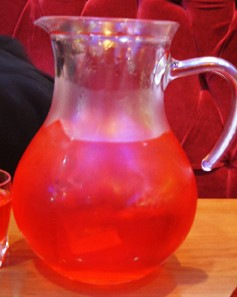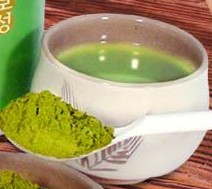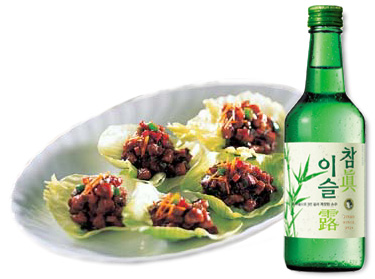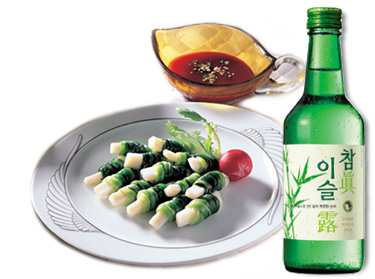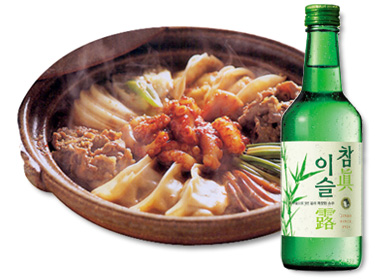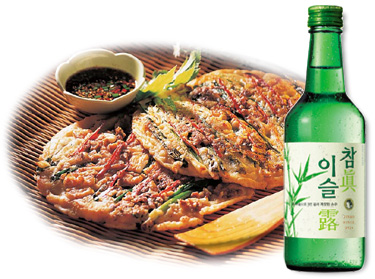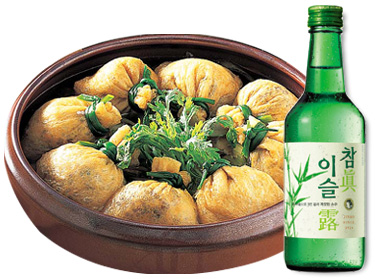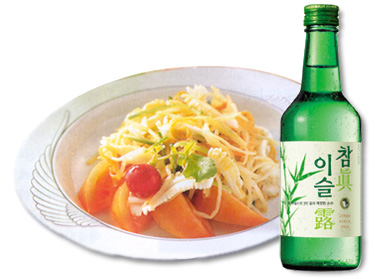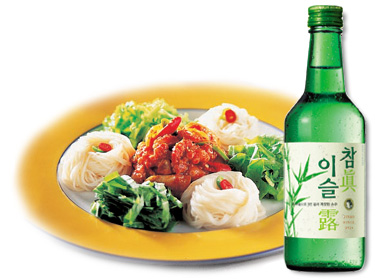|
Number 756, 2004 by Joonhye Han |
|
General
Information
Legal Cluster Bio-Geographic Cluster Trade Cluster Environment Cluster Other Clusters |
I. Identification1. The Issue
2. Description For Korean people, Soju is called 'A friend of life' and 'Common people's drink'. With Soju, common people can relieve some of their burden or share their happiness with each other or even drown their grief. The popularity of Soju in Korea cannot be overestimated. Korea has so many eating establishments per city and if you walk past any restaurant and you can find tables littered with Soju bottles, and the restaurants littered with customers at varying levels of intoxication.They can get closer to each other with Soju. In Korean culture of that people value the relationship between them above everything else, soju is a medium of culture and that is why Soju has been remained cheaper price than any other alcohol. There seems to be a distinct difference in opinion between the sexes about soju in Korea. Korean men appear to love the stuff and many of them claim that soju increases stamina. Korean men are not soft touches when it comes to drinking. Far from it. The word soju to most Korean women is something approaching a mild panic - an explosive squeal of disgust, a deeply pained expression, head shaking, hand waving. That's not to say they don't drink it. It's just they don't seem particularly like it, even as they pour it down their throats. I can say the taste of Soju to me is similar to ethanol mixed with water, of course I've never tried ethanol before so this comparison is purely guesswork with smell. Some of women can't drink soju because of this taste of ethanol. Soju has been a Korean traditional alcoholic beverage since the late of the Gorye period(918-1392) and the period of the Won Dynasty in China, Soju was introduced into Korea under the name of 'Sul'. Originally, Sul was from Arabia to the Mongols of the Won Dynasty, then to Manchuria and into Korea. At that time, there were special buildings called Yangonseo where "Sul" was made in palaces for special events like national celebration.
However,
this became outlawed under the Japanese occupation (1910~1945) and the
Japanese issued brewing licenses to favored local supporters.This license
made brewers produce drink in large quantities and formed the beginning
of industrial Sul making in Korea. During
this period, western alcoholic beverages such as beer, whisky and wine
were introduced to Korea. Because of their high price, these drinks
became popular among the wealthy, while Soju have been preserved among
the common people. The government is very cautious about raising tax
rates on soju, because it affects people's daily lives. [Table
1.
Comparative table between distilled and diluted soju]
[Table
2.
Delivered Quantity of Alcohol in Korea by year]
However in 1997, the EC and the U.S. claimed that the contested measures are inconsistent with Article 3:2 of the GATT 1994 because they accord preferential tax treatment to diluted Soju as compared with certain imported "western-style" alcoholic beverages. WTO Distribute Settlement Body gave a conclusion that Korea government should harmonize existing 35% tax rate of Soju with 100%, same as Whisky. However, the Korean Liquor Tax Law imposes an ad valorem tax on all alcoholic beverage and it is different from the Liquor tax law imposing a specific tax of most WTO member countries include the U.S. and the EU. Under the ad valorem tax law, the EU and the U.S. insisted that it is violation of the Article 3: 2 of GATT regulation.
In July 2000, Korea government increased tax rate on Liqour from 35% to 80%. It was unavoidable decision as a member of WTO because if the member don't perform its duty, the other members can inflict serious loss on that member country. the U.S. and the EU are putting in a claim for increasing 20% more tax rate on soju. And the Korean government made a declaration of performing it step by step. Despite increased tax rate on soju from 35% to 80%, the price of it still has much more gap with that of Whisky. That will be helpful to Korean government on revenues while that will burden the people who are the major consumer of Soju with higher price. [Table.3
Comparison Liquor Tax Amount per liter]
[Table
4. Changed price of Consumer's price after amendation]
The problem is even these cheaper price can impose a burden on common people who are major customers of soju. Actually, largely Korean people like dining together after their works or meeting with their friends with soju. After they have a dinner or when they have it, they usually enjoy the mood of drinking or just drinking itself. At this moment, most of drinking beverages have been soju, sometimes beer as well. With soju, people sometimes play a drinking game for fun and from this, they can get closer than before. Since 1960s, soju has been the pleasure of life to wage earners who toil and moil with a small salary, but play the leading role in development. Because of its cheap price and social environment, soju is indispensable to Korean people's life like food and water. However, Korean goverment are planning to increase the tax on soju as same as that on whicky. If then, the price of soju will increase and common people can somtimes hesitate to drink soju. A rise in the price of soju can result in a rise in the difficulties of life. It thus appears that it will affect to Korean Soju industry in the long term. At the slightest slip, culture of soju that is already formed strongly in Korean society might be changed or be disappeared. To prevent these results and to reduce the amount of loss on soju industry, there can be two alternative proposals. One is to make dose of 1 bottle smaller so that people can enjoy the mood of drinking soju as same as before with same price. And the other is to make proof of soju lighter than now so that the tax on soju can be decreased. And internationally, Soju can be the world alcoholic beverage.
[Table 7. Korean Soju exporting countries]
Soju
companies should develop their soju products to suit foreigner's taste
and one proposal on here is to export fruit soju to the EU and the U.S.
In EU and the U.S., they enjoy wine made of fruit. Korean soju also
has several types of fruit soju as well as green tea, yogurt, cucumber
soju. If Korean Soju companies develop their fruit soju to suit the
western people's taste, they can get much advantage from it. Moreover,
even pure soju has been on the top of 3. Related Cases Alcohol Related
Cases Korean Cases
4. Author and Date: Joon Hye Han. Jun. 23. 2004 |
|||||||||||||||||||||||||||||||||||||||||||||||||||||||||||||||||||||||||||||||||||||||||||||||||||||||||||||||||||||||||||||||||||||||||||||||||||||||||||||||||||||||||||||||||||||||||||||||||||||||||||||||||||||||||||||||||||||||||||||||||
II. Legal Clusters5. Discourse and Status: Agreement (Decision) Soju is cheaper than any other alcohol in Korea. That can be one of the reasons why Soju is the most popular traditional drink in Korea. The Korean government had been supporting this Soju industry with lower taxes compared to other alcohol from foreign countries. In 1997, the EC and the U.S. claimed that the contested measures are inconsistent with Article 3:2 of the GATT 1994 because they accord preferential tax treatment to diluted Soju as compared with certain imported "western-style" alcoholic beverages. [Table
8. A Change of Korean Liquor Tax Rate]
According
to the EC, in Article3:2 of the GATT 1994, the notion of "like
product" in the first sentence is construable narrowly and the
EC notes according to the "Appellate Body Report on Japan - Taxes
on Alcoholic Beverages" that minor differences in taste, color
and other properties (including differences in alcohol contents) do
not prevent products from qualifying as like products. However, Korea
stresses the importance of the methodology used to compare domestic
and imported products under Article3 :2. It considers that the Panel
committed a major legal error in wrongly defining the comparison it
had to undertake. The Panel grouped together products that are not physically
identical; are used different ways by different manufacturers using
different raw materials; taste differently; are used differently; are
marketed and sold differently at considerably different prices and are
subject to different tax rates in Korea. The Panel also failed to carry
out a separate analysis for diluted and distilled soju.(Panel Report,
para. 10.54) Korea urges that the panel erred in conducting its analysis
on the basis of an agglomeration of the characteristics of two such
different products. To extend conclusions that are primarily based on
diluted soju to distilled soju is unacceptable logic. Further, by treating
diluted soju and distilled soju together, the Panel overlooked the relevance
of the considerable price differential between diluted soju and whisky.
Nevertheless, WTO DSB concluded that Korean government should raise
the liquor tax rate of soju into 100%, same rate as whisky. Because
the WTO Appellate Body has confirmed that Korea's tax regime is in violation
of is WTO obligations under GATT Article 3: 2(non-discrimination between
imported and domestic products), Korea levies liquor tax at significantly
lower rates on soju, which is almost exclusively produced in Korea,
than on other categories of spirits. This
follows last July's victory for the EU, when the original WTO panel
found that korea's law was in breach of international trade rules. Both
the European industry, which has suffered serious trade damage from
the current Korean regime, and the European Comission are expected to
closely follow the implementation of the ruling.(Information
from <Korea-Teaes on Alcoholic Beverages AB-1998-7, Report of the
Appellate Body> World Trade Organization ) 6. Forum and Scope:
WTO
and Multilateral
Korea
maintains a multi-tiered taxation regime on the sale of alcoholic beverages.
Under the Liquor Tax Law 1949, as amended, Korea creates various categories
of distilled spirits, on which it imposes different as valorem taxes.
Under the Education Tax Law 1982, as amended, Korea assesses a surtax
on certain of these sales, determined as a percentage of the established
liquor tax. Both the liquor tax and the education tax on alcoholic beverages
are imposed at the wholesale level. The liquor Tax law lays down a system
of excise taxes applicable to all alcoholic beverages intended for consumption
in Korea. The taxes applied to the categories in dispute are in the
form of ad valorem taxes. Under the Education Tax Law of 1990 is
assessed as a surtax on the sale of a variety of items, including most
alcoholic beverages. For alcoholic beverages, the applicable rate is
determined by reference to another tax-the applied liquor tax rate.
For those assessed a liquor tax rate of 80% or greater, the law imposes
an education surtax calculated as 30% of the liquor tax imposed. The
applicable rates on the categories concerned by this dispute, expressed
as a percentage of the amount payable pursuant to the Liquor Tax, is
as follows.
[Table 9. Liquor and Education Tax Rate in Korea] source : Korean Taxation: 1997, 3(b) p.188, Korean Ministry of Finance and Economy
According
to the Korean law, every consumption tax is based on ad valrem tax system,
so it is difficult to switch from ad valrem tax system to specific tax
system only for Liquor case. This taxation system depends on situation
of the member countries and WTO commits this matter to them. But the
EU and the U.S. claimed that Korea should raise the liquor tax amount
of soju according to the specific tax system, not to the ad valrem tax
system. DSB, however, concluded that Korea should amend the soju tax
rate within a Korean tax system.
[Table 10. Comparison Tax amount among countries] source : Korean Liquor Taxation Report on Amedment : 1999. 9. 14 Korean Ministry of Finance and Economy
According to the Table 6 above, EU and the U.S follow the specific tax system so the Liquor tax amount is decided according to alcohol proof. Moreover, International legulation on Liquor tax rate is based on the princple of 'High amount of tax rate on high proof, low amount of tax rate on low proof'. So, It is term advantageous to Korean Alcohol which has lower proof than Whisky. 7. Decision Breadth: 1 Korea 8. Legal Standing: Treaty
|
|||||||||||||||||||||||||||||||||||||||||||||||||||||||||||||||||||||||||||||||||||||||||||||||||||||||||||||||||||||||||||||||||||||||||||||||||||||||||||||||||||||||||||||||||||||||||||||||||||||||||||||||||||||||||||||||||||||||||||||||||
III. Geographic Clusters9. Geographic Locations a. Geographic Domain: Asia b. Geographic Site: East Asia c. Geographic Impact: South Korea, the EU, the U.S., Chaina, Japan 10. Sub-National Factors: No 11. Type of Habitat: Temperate
|
|||||||||||||||||||||||||||||||||||||||||||||||||||||||||||||||||||||||||||||||||||||||||||||||||||||||||||||||||||||||||||||||||||||||||||||||||||||||||||||||||||||||||||||||||||||||||||||||||||||||||||||||||||||||||||||||||||||||||||||||||
IV. Trade Clusters12. Type of Measure: Intellectual Property Traditionally, soju was made of potatos and grain. Washed and steamed rice is cooled with cold water and then, mashed and fermented glutinous rice called Nuruk or regular rice is added. After stirring well, keep about a week until it is fermented. When it is fermented, it is put into a cauldron over a fire and boiled. The distilled alcohol forms on the surface of the vessel filled with cold water, which is Soju. But the Soju which is currently spent is diluted Soju, so that its alcohol proof is lower and taste is not bitter than distilled Soju. Nowadays, this diluted Soju came to represent Korean alcohol and is getting more and more famous in the world. Soju has under 25% alcohol and there are various kinds of soju which has lower alcohol proof than before. These days, lighter alcohol is more popular than stronger one among Korean young people. There are many kinds of Soju in Korea. The most famous brand is "Jinro". There are several kinds of Jinro Soju below.
13. Direct v. Indirect Impacts: Yes 14. Relation of Trade Measure to Environmental Impact a. Directly Related to Product: Yes, Soju b. Indirectly Related to Product: No c. Not Related to Product: No d. Related to Process: Yes, Intellectual Property
15. Trade Product Identification: various types of Soju
Cherry Soju
16. Economic Data 17. Impact of Trade Restriction: Low 18. Industry Sector: Food 19. Exporters and Importers: EU, the U.S, Japan and China These various tyes of Soju can suitable for the people's taste in EU, the U.S. Japan and China because pure soju is already on sale on these countries' alcohol market and ranking high sales records so far. It means that those countries people are accepting the taste of soju. Chinese women as well as westerners can easily enjoy this low alcohol proof soju with sweet smell of fruit like wine, but special taste. |
|||||||||||||||||||||||||||||||||||||||||||||||||||||||||||||||||||||||||||||||||||||||||||||||||||||||||||||||||||||||||||||||||||||||||||||||||||||||||||||||||||||||||||||||||||||||||||||||||||||||||||||||||||||||||||||||||||||||||||||||||
V. Environment Clusters20. Environmental
Problem Type: 21. Name, Type, and Diversity
of Species
22. Resource
Impact and Effect:
23. Urgency and Lifetime:
24. Substitutes:
|
|||||||||||||||||||||||||||||||||||||||||||||||||||||||||||||||||||||||||||||||||||||||||||||||||||||||||||||||||||||||||||||||||||||||||||||||||||||||||||||||||||||||||||||||||||||||||||||||||||||||||||||||||||||||||||||||||||||||||||||||||
VI. Other Factors25. Culture: yes People usually drink Soju when they are at mess with colleagues or when they are worried about something or happy meet friends. Sometimes, when people have special events or go to retreat with their friends or schoolfellows, Soju is a requisite to be closed each other or they refresh themselves by it. With Soju, they play a game which brings people into closer relationship each other or they can have a heart-to-heart talk. There is a reason why soju price became cheap. In the period of the Third Reblic(1963~72), the government inhibited from raising the Soju price so that low-wage earners who were considered as pillars of society could unburden themselves with Soju. Moreover, in 1965, Korea had the difficulty of obtaining food and government made the Cereals Policy not to brew the soju from rice and distilled soju changed diluted soju due to this law. Therefore, the cost price of Soju had been maintained low price and became common people's alcohol. Because of cheap price, people can easily access and enjoy it. Korea has a culture of Soju tents which are quite literally tents along the side of a city street that serve soju with a variety of food as below.
26. Trans-Boundary Issues: 27. Rights: 28. Relevant Literature |
|||||||||||||||||||||||||||||||||||||||||||||||||||||||||||||||||||||||||||||||||||||||||||||||||||||||||||||||||||||||||||||||||||||||||||||||||||||||||||||||||||||||||||||||||||||||||||||||||||||||||||||||||||||||||||||||||||||||||||||||||
| Sojujuso
Website Korea
, Tokyo
Report, Worldtrade
reports, lifeinKorea,
Drinking habit of Korea University students, doosan, Soju dispute, Korean
drinks and alcohol, One
burdon one soju and one beer, |
|||||||||||||||||||||||||||||||||||||||||||||||||||||||||||||||||||||||||||||||||||||||||||||||||||||||||||||||||||||||||||||||||||||||||||||||||||||||||||||||||||||||||||||||||||||||||||||||||||||||||||||||||||||||||||||||||||||||||||||||||

 Korean
government as a member of the WTO. Therefore, Korean government amended
the tax rate of Soju from 35% to 80% and is going to raise the tax of
it continuously until the tax rate of Whisky become same with that of
Soju.
Korean
government as a member of the WTO. Therefore, Korean government amended
the tax rate of Soju from 35% to 80% and is going to raise the tax of
it continuously until the tax rate of Whisky become same with that of
Soju. 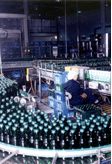
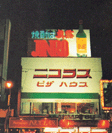
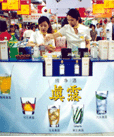
 Japanese
Alcohol markets for 5years. In Chinese case, it is a potential market
for Soju. The most famous alcohol to Chinese is Baijiu that has over
50% proof of alcohol and bitter taste. Because of these reasons, Chinese
women cannot get easily access to Baijiu. Using this fact, Soju company
can export soju intended for Chinese women. Fruit Soju which is light
and sweet can be suitable for chinese women's taste.
Japanese
Alcohol markets for 5years. In Chinese case, it is a potential market
for Soju. The most famous alcohol to Chinese is Baijiu that has over
50% proof of alcohol and bitter taste. Because of these reasons, Chinese
women cannot get easily access to Baijiu. Using this fact, Soju company
can export soju intended for Chinese women. Fruit Soju which is light
and sweet can be suitable for chinese women's taste. 


